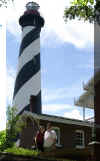Animations
MATH APPLICATIONS WITH DIGITALCAMERAS
Your phone's digital camera (or your students') is an excellent tools for enhancing the math classroom. They can also assist with applications under the current math reform movement, moving away from isolated problems in a drill-and-practice format to one more rooted in authentic experiences and problem solving.
Digital images can be used to help demonstrate accomplishment of standards such as National Council for Teachers of Mathematics (NCTM) standards for Algebra, Geometry and Measurement. For example, you could apply standards from by having images that allow students to measure and compare sides, shape and angles by using images as models. The NCTM standards include the statement that "Similarity also can be related to such real-world contexts as photographs, models, projections of pictures" which can be an excellent application of a digital image. NCTM encourages that "Students at all levels should have opportunities to model a wide variety of phenomena mathematically in ways that are appropriate to their level." Additionally while interacting with the digital images, students are also meeting the national technology standard (ISTE) specifying that students use technology tools to publish and interact with peers, experts and other audiences. Using digital images can provide documentation for the teacher, and allow for the creation of more authentic assessment tools and examples.
| Use your digital camera to demonstrate perspective by showing objects situated at different distances, or set up a discrepant event as displayed in this image where a known larger object appears smaller than a comparative known smaller object. |
Chicago IL, Field Museum')" _wpro_href="javascript:makePopUpWin('images/descrepant.jpg','Discrepant event image caused by background reference',241,234,'Discrepant event image caused by background reference,<br> Chicago IL, Field Museum')" class="">
|
| Scale and measurements: Use your camera to capture objects at the same distance to calculate the height of an unknown object or to calculate the volume of an object. Geometric shapes are shown here with the lighthouses as cylinder and conic sections. |
Mayport Florida')" _wpro_href="javascript:makePopUpWin('images/lighthouse.jpg','Mayport Lighthouse image',493,200,'Lighthouse - Cylinder Section,<br> Mayport Florida')" class=""> St. Augustine Florida')" _wpro_href="javascript:makePopUpWin('images/st_a_lig.jpg','St. Augustine Lighthouse image',500,309,'Lighthouse - Conic Section,<br> St. Augustine Florida')" class="">
St. Augustine Florida')" _wpro_href="javascript:makePopUpWin('images/st_a_lig.jpg','St. Augustine Lighthouse image',500,309,'Lighthouse - Conic Section,<br> St. Augustine Florida')" class="">
|
| You can enhance through photo-manipulation existing geometric shapes by adding highlights to the images to outline the shapes. In this image, a picture of the front of a building was enhanced to show the basic shapes on the building, including the triangle, rectangle, semicircle, square, and others. |   |
| Show objects that demonstrate structural strength, tension, and construction using geometry. In these photos a bridge which uses the basic structural shape of triangles with the tension wires, but also shows parabolas in the shape of the bridge. |   |
|
Use the digital camera to demonstrate, display, or print calculator procedures. With today's modern graphing calculators you can use your digital camera to capture images of the the steps in a calculation process along with the associated displays from the calculator screen. The process takes you beyond what you can accomplish with a calculator overhead LCD repeater or screen capture program on a computer. |
   |
| Demonstrate math manipulatives. Using a camera with live video output, students can participate in problem-solving while watching the steps on a large screen TV. The images can then be included in assessment tools, with the advantage of being more authentic. |   |
| Use digital images to perform scale measurements. With
these images of lizard tracks and a quarter as a scale reference object,
students can calculate the distances between foot prints and then use Alexander's formula (see formula)
to calculate the speed at which the animal
was moving
Alexander's formula for indirect speed measurement Estimated Speed (meters/second) = (0.25) x (gravitational constant)0.5
x (stride length)1.67 x (hip height)-1.17 |

|
Images can be used to develop and provide concrete examples of geometric shapes, symmetry and patterns, such as tessellations. Additionally, digital cameras can be used for math application labs covering topics such as direct and indirect measurement, man-made and natural geometry, money and counting, measurement and scale, and the calculations of speeds and distances.
